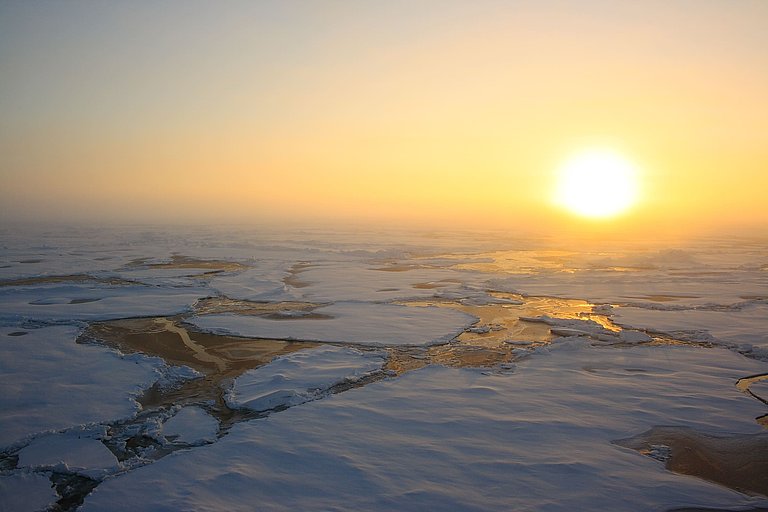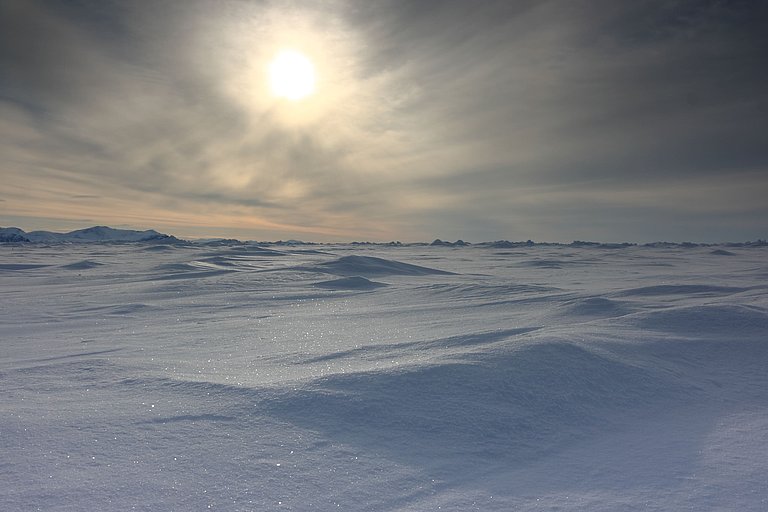Bacteria
The smallest inhabitants of the sea ice are the bacteria and archaea. Although the two groups are closely related, there are differences in their genetic blueprints, which is why they are classified separately. Since bacteria and archaea lack cell nuclei, they are referred to as prokaryotes – i.e., ‘coreless’ organisms. Bacteria are commonplace in sea ice, and can be found in all layers and every season. Archaea are less common.
The bacteria’s main task is to mineralise organic material produced by other organisms in the micro-biological community of the sea ice (Staley and Gosink, 1999). The sea-ice bacteria community is predominantly heterotrophic and primarily assimilates dissolved organic carbon (DOC) in order to produce biomass and energy (Staley and Gosink, 1999). To a lesser extent, it is also involved in breaking down particulate organic carbon (POC). In this context, ‘heterotrophic’ means the amount of carbon that a given organism needs for energy cannot be provided by photosynthesis, as plants do, and instead has to be supplied by consuming food. The bacterial production rates are high and can metabolise ca. 10–15 % of primary production (Staley and Gosink, 1999).
Depending on the region, local living conditions and season, the density of bacteria in sea ice varies considerably. Sea-ice bacteria not only have to cope with temperatures far below freezing, but also with high salinity levels, as well as seasonal and daily fluctuations in these extremes. The sea ice forms in autumn. This is also the time in which the bacteria become trapped in the growing ice.
Studies have shown that the bacterial density in sea ice is considerably higher than in the seawater beneath it. This accumulation is the result of physical processes that take place in the ice-formation phase. Plankton are embedded in the growing sea ice. Observations have shown that bacteria accumulate in young, freshly formed ice. Though typically the bacterial enrichment factor is 5 to 10 times as high as in seawater, the concentration can range from 2 to 54 times as high (Deming and Collins, 2017). Especially larger particles become embedded in the sea ice. Accordingly, it is generally assumed that bacteria find their way from the seawater into the forming sea ice through the accumulation of larger particles, which especially adhere to algae cells with a ‘sticky’ exterior coating. In addition, organic detritus (fine material produced by the breaking down of animal and plant matter), grains of sediment, and so-called aggregates, which are trapped in the ice structure, transport bacteria to the nascent sea ice. It has been estimated that ca. 50 percent of all bacteria in sea ice are attached to surfaces (Deming and Collins, 2017).
Though some bacteria prove unable to adapt to life in the ice, a healthy sea-ice bacterial community is nevertheless established. The overall success of adjustment is reflected in productions of the sea-ice bacteria, which exceeds the ice algae production during this season. As temperatures con-tinue to fall in winter, the liquid portion of the ice steadily declines. A certain amount of sea salt remains trapped in the ice, in the form of highly concentrated brine. The bacteria accumulate in this brine. At the same time, the activity of the bacteria reaches its minimum at this time of year, and the bacterial population declines (Deming and Collins, 2017). In spring, the bacterial production on the underside of the ocean-ice interface layer increases once again, a phenomenon that has been observed in both the Arctic and the Antarctic. This is when the ice algae ramp up their metabolism, and the bacteria live on their metabolic products, especially newly formed dissolved organic material. But also in the upper layers of the ice, where algae don’t grow or can’t be found, the number of bacteria increases. There, the bacteria feed on the dissolved organic material already available (Deming and Collins, 2017). As the number of bacteria rises, so does the number of organisms that feed on them – such as protists, which naturally limit the number of bacteria. In summer, the bacterial density in ice is usually the highest, as it coincides with the summertime ice algae blooms in the Arctic and Antarctic sea ice.
The bacterial diversity in sea ice is astounding. Sea-ice bacterial communities in the Arctic and Antarctic are home to heterotrophic members of the classes Flavobacteriia and Gammaproteobacteria, and to a lesser extent, Alphaproteobacteria, Verrucomicrobia and Bacilli (Boetius et al., 2015). Researchers have only known there were archaea in sea ice since this century, when the technologies became available to identify archaea genes. The archaea species in the ice belong to the phyla Thaumarchaeota and Euryarchaeota. Overall, the number of archaea in the sea ice is substantially lower than the number of bacteria. In terms of their occurrence, the contribution of archaea to the overall microbial community in the sea ice, regardless of latitude or season, is low (< 7 %). Nevertheless, their ecological relevance shouldn’t be underestimated (Deming and Collins, 2017).
Due to their heterotrophic feeding behaviour, bacteria play an important part in sea ice. They are primarily responsible for recycling nutrients in sea ice. Bacteria…
- are a central component of the food web because, through metabolism, they provide nutrients for other organisms. Generally speaking, the nutrient concentrations in the sea ice are lower than in the seawater. Bacteria are e.g. a biological source of inorganic nutrients like phosphate (PO43-), an important nutrient for plants. In addition to phosphate, they release other important micro- and macronutrients. In the Arctic, nitrate (NO3-) is the most important limiting nutrient, while iron and silicate are more important in the Antarctic. The conversion of organic material into inorganic materials is referred to as remineralisation (Meiners and Michel, 2017).
- are a food source for heterotrophic and mixotrophic protists. As such, in the food web, bacterial biomass provides a link between the microbial levels and those levels that include single-celled and higher / multicellular life forms, the metazoan food webs (Meiners and Michel, 2017).
- produce gelatinous biopolymers (extracellular polymer substances (EPSs)), which are important for bacteria’s survival in the ice. Like a natural form of ‘antifreeze’, EPSs alter the microstructure of the ice by e.g. preventing the formation of larger ice crystals that could damage membranes. As a result, they help to expand the habitat in sea-ice pores, and to ensure the brine remains liquid. Bacterial production of EPSs can be triggered by a drop in temperature or salinity.
Boetius, A., A.M. Anesio, J. W. Deming, J.A. Mikucki, & J.Z. Rapp (2015): Microbial ecology of the cryosphere: sea ice and glacial habitats. Nat Rev Microbiol., 13(11), 677-90. doi: 10.1038/nrmicro3522. Epub 2015 Sep 7. PMID: 26344407.
Deming J. W. & R. E. Collins (2017): Sea ice as a habitat for Bacteria, Archaea and viruses, In: D. N. Thomas (ed.), Sea Ice 3rd edition, Chapter 13, 326-351.
Meiners, K.M. & C. Michel (2017): Dynamics of nutrients, dissolved organic matter and exopolymers in sea ice, In: D. N. Thomas (ed.) Sea Ice, 3rd edition, Wiley-Blackwell, Chichester (UK) Hoboken (NJ), 415-432.
Staley J. T. & J. J. Gosink (1999): Poles Apart: Biodiversity and Biogeography of Sea Ice Bacteria, Annual Review of Microbiology, 53:1, 189-215, https://doi.org/10.1146/annurev.micro.53.1.189.


